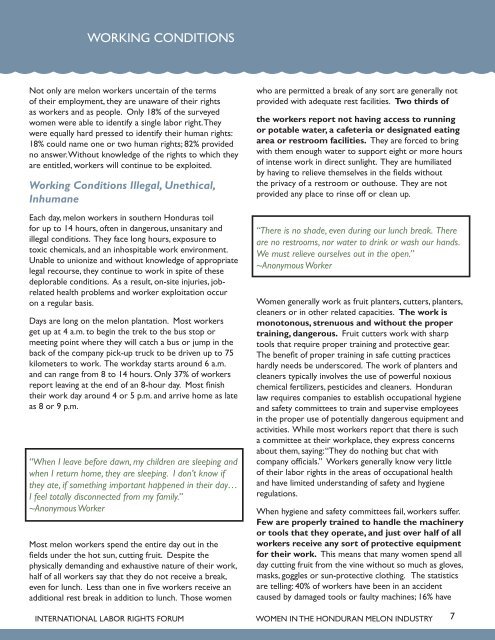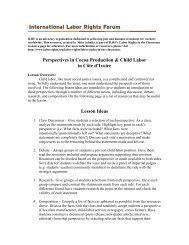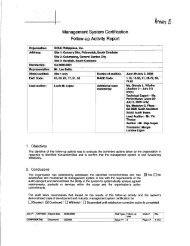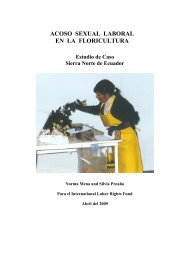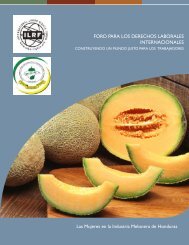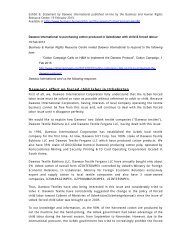Women in the Honduran Melon Industry - International Labor Rights ...
Women in the Honduran Melon Industry - International Labor Rights ...
Women in the Honduran Melon Industry - International Labor Rights ...
Create successful ePaper yourself
Turn your PDF publications into a flip-book with our unique Google optimized e-Paper software.
WORKING CONDITIONSNot only are melon workers uncerta<strong>in</strong> of <strong>the</strong> termsof <strong>the</strong>ir employment, <strong>the</strong>y are unaware of <strong>the</strong>ir rightsas workers and as people. Only 18% of <strong>the</strong> surveyedwomen were able to identify a s<strong>in</strong>gle labor right. Theywere equally hard pressed to identify <strong>the</strong>ir human rights:18% could name one or two human rights; 82% providedno answer. Without knowledge of <strong>the</strong> rights to which <strong>the</strong>yare entitled, workers will cont<strong>in</strong>ue to be exploited.Work<strong>in</strong>g Conditions Illegal, Unethical,InhumaneEach day, melon workers <strong>in</strong> sou<strong>the</strong>rn Honduras toilfor up to 14 hours, often <strong>in</strong> dangerous, unsanitary andillegal conditions. They face long hours, exposure totoxic chemicals, and an <strong>in</strong>hospitable work environment.Unable to unionize and without knowledge of appropriatelegal recourse, <strong>the</strong>y cont<strong>in</strong>ue to work <strong>in</strong> spite of <strong>the</strong>sedeplorable conditions. As a result, on-site <strong>in</strong>juries, jobrelatedhealth problems and worker exploitation occuron a regular basis.Days are long on <strong>the</strong> melon plantation. Most workersget up at 4 a.m. to beg<strong>in</strong> <strong>the</strong> trek to <strong>the</strong> bus stop ormeet<strong>in</strong>g po<strong>in</strong>t where <strong>the</strong>y will catch a bus or jump <strong>in</strong> <strong>the</strong>back of <strong>the</strong> company pick-up truck to be driven up to 75kilometers to work. The workday starts around 6 a.m.and can range from 8 to 14 hours. Only 37% of workersreport leav<strong>in</strong>g at <strong>the</strong> end of an 8-hour day. Most f<strong>in</strong>ish<strong>the</strong>ir work day around 4 or 5 p.m. and arrive home as lateas 8 or 9 p.m.“When I leave before dawn, my children are sleep<strong>in</strong>g andwhen I return home, <strong>the</strong>y are sleep<strong>in</strong>g. I don’t know if<strong>the</strong>y ate, if someth<strong>in</strong>g important happened <strong>in</strong> <strong>the</strong>ir day…I feel totally disconnected from my family.”~Anonymous WorkerMost melon workers spend <strong>the</strong> entire day out <strong>in</strong> <strong>the</strong>fields under <strong>the</strong> hot sun, cutt<strong>in</strong>g fruit. Despite <strong>the</strong>physically demand<strong>in</strong>g and exhaustive nature of <strong>the</strong>ir work,half of all workers say that <strong>the</strong>y do not receive a break,even for lunch. Less than one <strong>in</strong> five workers receive anadditional rest break <strong>in</strong> addition to lunch. Those womenwho are permitted a break of any sort are generally notprovided with adequate rest facilities. Two thirds of<strong>the</strong> workers report not hav<strong>in</strong>g access to runn<strong>in</strong>gor potable water, a cafeteria or designated eat<strong>in</strong>garea or restroom facilities. They are forced to br<strong>in</strong>gwith <strong>the</strong>m enough water to support eight or more hoursof <strong>in</strong>tense work <strong>in</strong> direct sunlight. They are humiliatedby hav<strong>in</strong>g to relieve <strong>the</strong>mselves <strong>in</strong> <strong>the</strong> fields without<strong>the</strong> privacy of a restroom or outhouse. They are notprovided any place to r<strong>in</strong>se off or clean up.“There is no shade, even dur<strong>in</strong>g our lunch break. Thereare no restrooms, nor water to dr<strong>in</strong>k or wash our hands.We must relieve ourselves out <strong>in</strong> <strong>the</strong> open.”~Anonymous Worker<strong>Women</strong> generally work as fruit planters, cutters, planters,cleaners or <strong>in</strong> o<strong>the</strong>r related capacities. The work ismonotonous, strenuous and without <strong>the</strong> propertra<strong>in</strong><strong>in</strong>g, dangerous. Fruit cutters work with sharptools that require proper tra<strong>in</strong><strong>in</strong>g and protective gear.The benefit of proper tra<strong>in</strong><strong>in</strong>g <strong>in</strong> safe cutt<strong>in</strong>g practiceshardly needs be underscored. The work of planters andcleaners typically <strong>in</strong>volves <strong>the</strong> use of powerful noxiouschemical fertilizers, pesticides and cleaners. <strong>Honduran</strong>law requires companies to establish occupational hygieneand safety committees to tra<strong>in</strong> and supervise employees<strong>in</strong> <strong>the</strong> proper use of potentially dangerous equipment andactivities. While most workers report that <strong>the</strong>re is sucha committee at <strong>the</strong>ir workplace, <strong>the</strong>y express concernsabout <strong>the</strong>m, say<strong>in</strong>g: “They do noth<strong>in</strong>g but chat withcompany officials.” Workers generally know very littleof <strong>the</strong>ir labor rights <strong>in</strong> <strong>the</strong> areas of occupational healthand have limited understand<strong>in</strong>g of safety and hygieneregulations.When hygiene and safety committees fail, workers suffer.Few are properly tra<strong>in</strong>ed to handle <strong>the</strong> mach<strong>in</strong>eryor tools that <strong>the</strong>y operate, and just over half of allworkers receive any sort of protective equipmentfor <strong>the</strong>ir work. This means that many women spend allday cutt<strong>in</strong>g fruit from <strong>the</strong> v<strong>in</strong>e without so much as gloves,masks, goggles or sun-protective cloth<strong>in</strong>g. The statisticsare tell<strong>in</strong>g: 40% of workers have been <strong>in</strong> an accidentcaused by damaged tools or faulty mach<strong>in</strong>es; 16% haveINTERNATIONAL LABOR RIGHTS FORUMWOMEN IN THE HONDURAN MELON INDUSTRY7


